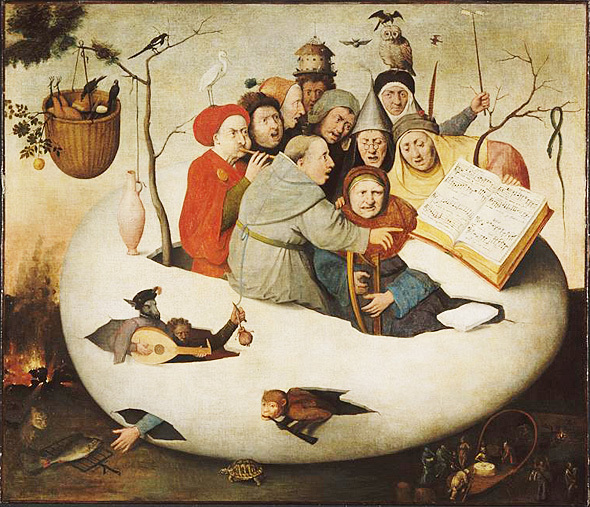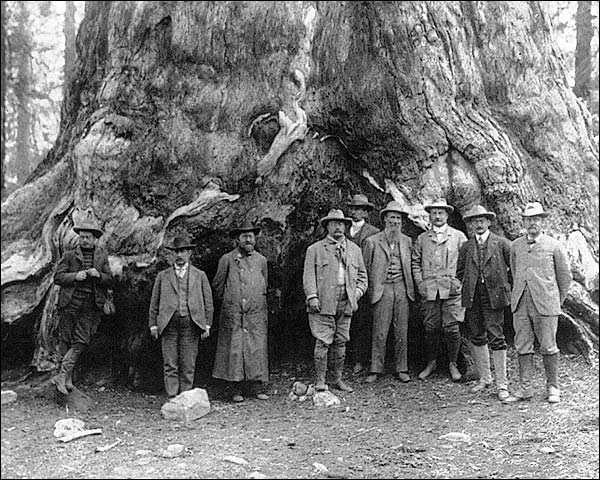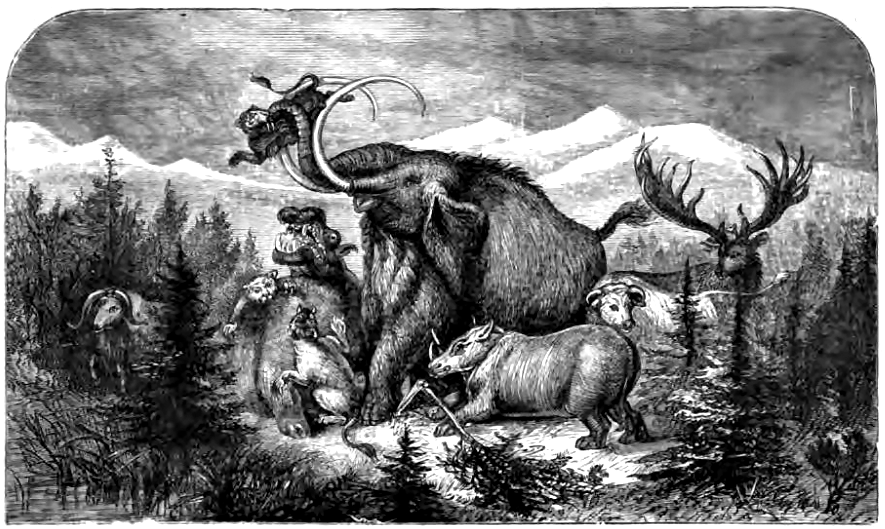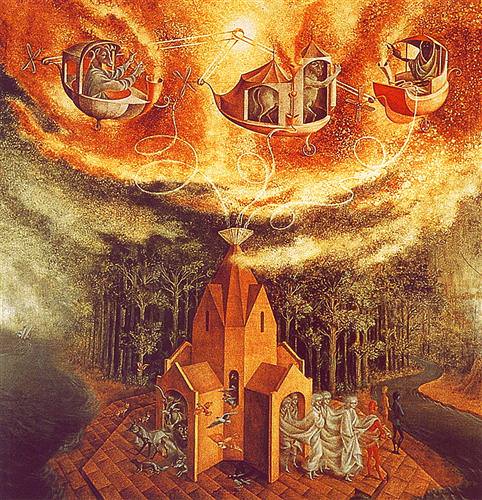
Perception of thyself, the knowledge of him who created thee,
the sense of the worship thou owest unto him, are not these plain
before thy face? And behold! what is there more than man needeth to
know? -- 21-87
At the heart of Thomas Pynchon's 1965 psychedelic masterpiece of paranoia and the postal underground,
The Crying of Lot 49, is a machine.
This machine has been designed by John Nefastis, an independent and somewhat disgruntled engineer and employee of Yoyodyne Inc. Yoyodyne, "
one of the giants of the aerospace industry," occasionally surfaces as a murky conglomerate in Pynchon's fictional universe, but even more bizarrely it came to transcend even this rich imaginative cosmos.
Inspired by
Lot 49, Yoyodyne would later appear in
The Adventures of Buckaroo Banzai Across the 8th Dimension!, and even within the endless domain of
Star Trek itself. The Nefastis Machine, a key to a great mystery, has become the prototype for equally esoteric devices in
Buckaroo Banzai,
Star Trek and through these, in post-Yoyodyne manifestations, to
Back To The Future and beyond.
Four of these machines, using
The Crying of Lot 49 as a guide to decode and decipher their arcane schemata, will be the focus of this essay: the Nefastis Machine, the Oscillation Overthruster, the Flux Capacitor, and the Yoyodyne Pulse Fusion Warp Drive.
The Sweet Breath of the Universe
In
The Crying of Lot 49, the principle of the Nefastis Machine is described as being derived from a thought experiment by Scottish scientist, James Clerk Maxwell, an early theorist of electricity. The thought experiment came to be called "
Maxwell's Demon":
The Demon could sit in a box among air molecules that were moving at all different random speeds, and sort out the fast molecules from the slow ones. Fast molecules have more energy than slow ones. Concentrate enough of them in one place and you have a region of high temperature. You can then use the difference in temperature between this hot region of the box and any cooler region, to drive a heat engine. Since the Demon only sat and sorted, you wouldn't have put any real work into the system. So you would be violating the Second Law of Thermodynamics, getting something for nothing, causing perpetual motion.
Perpetual motion. Unlimited energy. The fulfillment of the age long dream of getting something from nothing. A kind of space age horn of plenty.
Oedipa Maas, the protagonist of Pynchon's novel, quickly points out the problem in this equation. The demon, allowing for the moment that it could even exist, would still be required to separate the fast molecules from the slow molecules. Sorting itself, argues Oedipa, is a type of work.
Sorting
is a form of work, concedes Stanley Koteks, another employee of Yoyodyne and an advocate of the Nefastis Machine, but it is "
mental" work and not "
work in the thermodynamic sense." The demon requires information, but as its sorting, in the original thought experiment, is "
frictionless" it does no real work.

Oedipa remains unconvinced, but she is curious enough to venture up to Berkeley to meet the inventor himself, John Nefastis, and to request a demonstration of his miraculous machine. Nefastis attempts to explain how it operates. Essentially, it involves the interplay of two types of entropy:
One having to do with heat-engines, the other to do with communication. The equation for one, back in the '30's, had looked very like the equation for the other. It was a coincidence. The two fields were entirely unconnected, except at one point: Maxwell's Demon. As the Demon sat and sorted his molecules into hot and cold, the system was said to lose entropy. But somehow the loss was offset by the information the Demon gained about what molecules were where.
The demon, whose sorting mechanism is activated by a psychic "
sensitive" staring at a photograph of Maxwell, therefore, is the product of a mathematical synchronicity. It may even be the embodiment of the sync itself.
"Entropy is a figure of speech, then," sighed Nefastis, "a metaphor. It connects the world of thermo-dynamics to the world of information flow. The Machine uses both. The Demon makes the metaphor not only verbally graceful, but also objectively true."
A very insightful essay by N. Katherine Hayles, "'A Metaphor of God Knew How Many Parts': The Engine that Drives
The Crying of Lot 49," puts this into the context of the scientific debate, propelled by Maxwell's thought experiment, of the relation between entropy and information.
Claude Shannon, called the father of modern information theory, dissented from the more conventional view that entropy and information were opposites. Shannon, compelled by the coincidence of the identical equations for information and entropy, used the two terms interchangeably.
In Shannon's view, systems rich in entropy are not simply poor in order; rather, they are rich in information. The key is to think of disorder as maximum information. So influential has this view become that in contemporary irreversible thermodynamics, entropy is seen as an engine driving systems toward increasing complexity rather than dissolution. In cosmology, it has recently been used to construct a model of the universe that does not end in heat death, because entropy bestows upon it the capacity to renew itself.
Pynchon, regardless of how well-versed he was in this particular scientific debate when he was constructing
Lot 49 in the early Sixties, nonetheless intuitively
grokked the intimate connection of information and entropy, of order and disorder.
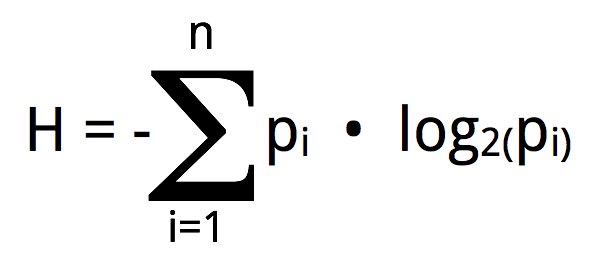
The Nefastis Machine, a device which generates energy from the differential of fast hot particles and slow cool particles, is itself an elaborate metaphor of the endless energy obtainable by the simultaneous positioning of order and chaos.
Apparently the purpose of the machine is to literalize the connection between information and entropy by converting information directly into mechanical energy... Just as a very small amount of mass is converted to an enormous amount of energy in Einstein's famous equation E=mc 2, so in the Nefastis Machine a huge amount of information is necessary to create a tiny amount of energy.
The almost impossible conjunction of mass and energy metaphorically parallels the equally uncanny, and yet more controversial, coupling of information and entropy. And for Pynchon it becomes clear that the atomic blast of imagination made possible by the conjoining of these opposites is as creative/destructive as anything derived from the Manhattan Project.
A Flipping Miracle
As in the magical work of Giordano Bruno, "
in tristitia hilaris, hilaritate tristis" -- "cheerful in the midst of sadness, sad in the midst of cheerfulness" -- which Joyce in typical and maximal poetic concision in the Wake isolates as "laughtears," Hell and Heaven celebrate their chymical wedding within the pages of Pynchon.
The ancient secret was divulged -- coinciding with the invention of the printing press -- by Nicholas of Cusa:
But the whole effort of our human intelligence ought to center on those lofty [matters], so that the intellect may raise itself to that Simplicity where contradictories coincide.
And it was this thread that Bruno and his esoteric and literary successors took up and continued to weave.
 Tristitia and hilaritas also appear explicitly in The Crying of Lot 49. Dr. Hilarius, Oedipa's therapist is, perhaps paradoxically, partially modeled on the life and career of Dr. Timothy Leary. Like Leary, Hilarius is an early advocate of the use of LSD-25 for therapeutic purposes. And as with the efforts of Leary, the results of Dr. Hilarius' psychedelic therapy are decidedly mixed.
Tristitia and hilaritas also appear explicitly in The Crying of Lot 49. Dr. Hilarius, Oedipa's therapist is, perhaps paradoxically, partially modeled on the life and career of Dr. Timothy Leary. Like Leary, Hilarius is an early advocate of the use of LSD-25 for therapeutic purposes. And as with the efforts of Leary, the results of Dr. Hilarius' psychedelic therapy are decidedly mixed.
Oedipa's husband, Mucho Maas (much more), a depressed and disenchanted DJ at Station KCUF (FUCK inverted -- the life force rechanneled towards commercialized death), becomes a victim of Hilarius' questionable prescriptions. Maas has mutated and multiplied into "a walking assembly of man," "a whole roomful of people," his identity encompassing the multitude. The one has become interchangeable with the many. And he achieved this transformation, via Hilarius' acid as catalyst, through sound.
Spectrum analysis, in my head. I can break down chords, and timbres, and words too into all the basic frequencies and harmonics, with all their different loudness's, and listen to them, each pure tone, but all at once.
And here, just as those on the cultural margins were starting to feel the faintest shockwaves of the coming psychedelic explosion, Pynchon is revealing something which McLuhan and others realized at about the same time. The Eye, at least in its print-based dominance of the culture, was being avenged by the Ear. The tribal drums were beating again.
Mucho Maas took the plunge back into the dark mass in pure ecstasy. His wife Oedipa, in her quest to unravel the riddle of Man, suffered the loss of individuality through increasing paranoia and dread.
 The spoken word, either live or recorded, in universal transmission through electricity, is the portal back into the mire. The texts themselves have become unstable and illegible. The carved letters have worn off the Tables of the Law. Literary detachment is no longer possible. At every instant that a word is spoken an immediate link is created between that particular speaker and everyone else, regardless of time and place, who has ever uttered the same word. The link is in fact so strong that it forges an identity.
The spoken word, either live or recorded, in universal transmission through electricity, is the portal back into the mire. The texts themselves have become unstable and illegible. The carved letters have worn off the Tables of the Law. Literary detachment is no longer possible. At every instant that a word is spoken an immediate link is created between that particular speaker and everyone else, regardless of time and place, who has ever uttered the same word. The link is in fact so strong that it forges an identity.
Everybody who says the same words is the same person if the spectra are the same only they happen differently in time, you dig? But the time is arbitrary. You pick your zero point anywhere you want, that way you can shuffle each person's time line sideways till they all coincide. Then you'd have this big, God, maybe a couple hundred million chorus saying 'rich, chocolaty goodness' together, and it would all be the same voice.
But this is madness, right? An obvious acid casualty, eh? Not so fast. Pynchon is marking the beginning of a new phase of culture, in the late 50s and early 60s, which later becomes categorized and watered down as "postmodern," and is the terrain of all his art. Immense energy is released when opposites are forced together. A sudden alchemical transformation of the senses has burst out in combined colour and sound:
When those kids sing about 'She loves you,' yeah well, you know, she does, she's any number of people, all over the world, back through time, different colors, sizes, ages, shapes, distances from death, but she loves. And the 'you' is everybody. And herself. Oedipa, the human voice, you know, it's a flipping miracle.
And the new era is distinctly psychedelic and electric:
You take it [LSD] because it's good. Because you hear and see things, even smell them, taste like you never could. Because the world is so abundant. No end to it, baby. You're an antenna, sending your pattern out across a million lives a night, and they're your lives too.
Madness and sanity, ecstasy and paranoia, speed and stasis, sound and vision, entropy and information, tristitia and hilaritas, all converge onto a single point. The artists as always -- Pound's "antennae of the race" -- are the first to notice and the first to make the transmission. The signal rapidly spreads, provoking an audible shudder through every citadel of power, increasing in volume to a dull roar. An earthquake of sound.
 Dr. Hilarius, a clinical father figure, a pillar and stalwart advocate of the reality principle becomes the victim of his own new eon medicine. LSD both shatters the facade of the beneficent patriarch and therapeut -- Hilarius is unveiled as an unrepentant former Nazi death camp mind control shrink -- and in this shattering invokes active and destructive paranoia -- he undertakes an armed assault on the police which he hallucinates as being Israeli secret service Nazi-hunters.
Dr. Hilarius, a clinical father figure, a pillar and stalwart advocate of the reality principle becomes the victim of his own new eon medicine. LSD both shatters the facade of the beneficent patriarch and therapeut -- Hilarius is unveiled as an unrepentant former Nazi death camp mind control shrink -- and in this shattering invokes active and destructive paranoia -- he undertakes an armed assault on the police which he hallucinates as being Israeli secret service Nazi-hunters.
But -- and this is precisely the paradoxical point where absolute control implosively flips into ultimate anarchy -- Dr. Hilarius' final psychoanalytic summation is expressed at this crisis as the furthest thing possible from Nazi ideology:
"I came," she said, "hoping you could talk me out of a fantasy."
"Cherish it!" cried Hilarius, fiercely. "What else do any of you have? Hold it tightly by its little tentacle, don't let the Freudians coax it away or the pharmacists poison it out of you. Whatever it is, hold it dear, for when you lose it you go over by that much to the others. You begin to cease to be."
Cherish your own singular madness, and do so proudly and in spite of whatever authority advises against it. Order becomes chaos, reality becomes fantasy. Every centre cannot hold. Mucho Maas is swept into multitude and ecstasy, Hilarius into singularity and paranoia, two poles of the same pulse.
Hilaritas becomes tristitia, and tristitia, in The Crying of Lot 49, is the shadowy Tristero, a subversive and underground postal network that has existed in challenge to the the imperial and official service since at least the late Renaissance.
As Oedipa's quest for truth progresses through Lot 49, more and more of the secret history of Tristero is unearthed.
The Silent Empire
The Tristero emerged in radical opposition to the Thurn and Taxis' continent-wide postal monopoly. The Thurn and Taxis themselves were quite historical. They were the postal service of the Holy Roman Empire, and they arose and fell in tandem with the Empire's fate, forming around 1300 and not dissolving until Bismark bought them out in 1867. As information equals power, their monopoly on communication brought them immense power. Any challenge to their authority, in effect, is a direct affront to the reality of Empire.
 The challenge came, as it often does, from within. In the late 1500s a rejected claimant to be rightful heir of the Thurn and Taxis estate and enterprise, Hernando Joaquin De Tristero y Calavera, decided to establish his own autonomous postal service. The Tristero was born.
The challenge came, as it often does, from within. In the late 1500s a rejected claimant to be rightful heir of the Thurn and Taxis estate and enterprise, Hernando Joaquin De Tristero y Calavera, decided to establish his own autonomous postal service. The Tristero was born.
He [Tristero] began a sub rosa campaign of obstruction, terror and depredation along the Thurn and Taxis mail routes.
And as one of Oedipa's fellow researchers observed:
...Any period of instability for Thurn and Taxis must have its reflection in Trystero's shadow-state.
Subversion is the mirror of Empire. Entropy is the mirror of information. After several centuries in pursuit of insurrection and overthrow, perhaps culminating with the French Revolution, the Tristero was finally and forcibly suppressed in Europe after the failed revolutions of 1848.
 But this was not to be the end of Tristero. It reformed itself in the U.S.A. -- the new heart of Empire, which undoubtedly "never ended" -- and rebranded itself as W.A.S.T.E., "We Await Silent Tristero's Empire." It's symbol continued to be the muted post horn, a sign of its violent opposition to the communications monopoly.
It is through this symbol that Oedipa picks up their scent. For in some inexplicable and maddening way, W.A.S.T.E. is connected to the estate of her billionaire ex-lover, Pierce Inverarity. Inverarity, after his passing, has willed Oedipa to be the executrix of this estate, and it is in the ordering of these affairs that Oedipa begins to get increasingly drawn into the Tristero mystery.
Inverarity is not just any billionaire. He is the major shareholder of Yoyodyne and seems to own most of the Californian town of St. Narciso, the fictional setting of the novel. The range and depth of Inverarity's influence and power often appears superhuman. He is all present and all knowing. He reminds one of Dick's Palmer Eldritch or Bowie's alien character in The Man Who Fell To Earth. He is Yoyodyne, in all of its power and intrigue, personified.
And as Oedipa becomes progressively ensnared into Tristero's dark web -- to the point where she seriously questions her own sanity -- she begins to suspect that Inverarity might be behind it all. Four distinct and mutually exclusive possibilities arise in her speculations, and these four may be fruitfully applied to all research into the Conspiracy and its equally shadowy counterpart. The passage is worth quoting at length:
But this was not to be the end of Tristero. It reformed itself in the U.S.A. -- the new heart of Empire, which undoubtedly "never ended" -- and rebranded itself as W.A.S.T.E., "We Await Silent Tristero's Empire." It's symbol continued to be the muted post horn, a sign of its violent opposition to the communications monopoly.
It is through this symbol that Oedipa picks up their scent. For in some inexplicable and maddening way, W.A.S.T.E. is connected to the estate of her billionaire ex-lover, Pierce Inverarity. Inverarity, after his passing, has willed Oedipa to be the executrix of this estate, and it is in the ordering of these affairs that Oedipa begins to get increasingly drawn into the Tristero mystery.
Inverarity is not just any billionaire. He is the major shareholder of Yoyodyne and seems to own most of the Californian town of St. Narciso, the fictional setting of the novel. The range and depth of Inverarity's influence and power often appears superhuman. He is all present and all knowing. He reminds one of Dick's Palmer Eldritch or Bowie's alien character in The Man Who Fell To Earth. He is Yoyodyne, in all of its power and intrigue, personified.
And as Oedipa becomes progressively ensnared into Tristero's dark web -- to the point where she seriously questions her own sanity -- she begins to suspect that Inverarity might be behind it all. Four distinct and mutually exclusive possibilities arise in her speculations, and these four may be fruitfully applied to all research into the Conspiracy and its equally shadowy counterpart. The passage is worth quoting at length:
Either you have stumbled indeed, without the aid of LSD or other indole alkaloids, onto a secret richness and concealed density of a dream; on to a network by which X number of Americans are truly communicating whilst reserving their lies, recitations of routine, arid betrayals of spiritual poverty, for the official government delivery system; maybe even on to a real alternative to the exitlessness, to the absence of surprise to life, that harrows the head of everybody American you know, and you too sweetie. Or you are hallucinating it. Or a plot has been mounted against you, so expensive and elaborate, involving items like the forging of stamps and ancient books... so labyrinthine that it must have meaning beyond just a practical joke. Or you are fantasying some such plot, in which case you are a nut, Oedipa, out of your skull.
Either an authentic and effective, though clandestine and criminal, opposition to the Empire really exists, operating covertly within its fissures and margins; or we are simply imagining and projecting such an organization as a kind of wish fulfillment; or we are caught up in an elaborate plot by TPTB to make us think that such an opposition exists; or we are hallucinating the existence of such a plot -- likely implying that we are are truly insane.
All such possibilities continue to exist, and none can be really ruled out. As the full spectrum dominance of the Empire becomes daily more totalizing any true rival would, of necessity, be its near match in absolute power, and perhaps in malevolent potential. More and more the two would resemble, if not in fact be, rival magical orders.
 Each would foremost be obsessed with obtaining complete control over the channels of communication, thereby ensuring absolute sway over human perception. Lot 49's "Tristero" is the equivalent of the "Counterforce" of Gravity's Rainbow, and is echoed in the "deep web" of Bleeding Edge, Pynchon's most recent novel.
It seems clear that Pynchon believes that such a counterforce -- at least in potential -- definitely does exist. And yet if we question its existence then we may, by the same argument, question the existence of the Empire itself. Perhaps the Counterforce is only projecting the image of an all-powerful Empire for its own nefarious purposes.
Or could it just be that we are all insane? And yet, as is laid out in Lot 49, extreme paranoia is simply the reflection of supreme ecstasy. As one becomes unstable the other becomes secure. We are all being sorted and unsorted by Maxwell's demons and angels.
Each would foremost be obsessed with obtaining complete control over the channels of communication, thereby ensuring absolute sway over human perception. Lot 49's "Tristero" is the equivalent of the "Counterforce" of Gravity's Rainbow, and is echoed in the "deep web" of Bleeding Edge, Pynchon's most recent novel.
It seems clear that Pynchon believes that such a counterforce -- at least in potential -- definitely does exist. And yet if we question its existence then we may, by the same argument, question the existence of the Empire itself. Perhaps the Counterforce is only projecting the image of an all-powerful Empire for its own nefarious purposes.
Or could it just be that we are all insane? And yet, as is laid out in Lot 49, extreme paranoia is simply the reflection of supreme ecstasy. As one becomes unstable the other becomes secure. We are all being sorted and unsorted by Maxwell's demons and angels.
The Pentecostal Church of Sputnik
It is in San Fransisco that Oedipa at last takes the final plunge into a foundationless Walpurgisnacht of ultimate paranoia/ecstasy. She begins to perceive or imagine the Tristero everywhere and in everything. All is infused with meaning. The entire sphere of perception becomes branded by the muted post-horn. Is this madness or revelation? The numeric in the book's title provides an obvious clue.
In an inspiring essay on Lot 49 by Pierre-Yves Petillon, "A Recognition of Her Errand into the Wilderness," this sign is uncovered.
The "whole story" of the novel takes place in an interim period of 49 days, a time which can be construed in two ways. First, 49 is 50 minus one, the fiftieth day of the Christian liturgical calendar (after Easter) being the Pentecost. The story takes place in the 49 days between the Easter rising of Christ and the awaited Pentecost when the Holy Ghost, speaking in a babble of voices, will typologically foreshadow the Day of Doom and ultimate revelation. But the 49 days also refers to another "interim," the 49 days during which, in the Tibetan Book of the Dead, the newly deceased slowly work their way toward final death and rest. In this sense, the interim period points not only forward to the "awful" things to come, but also backward toward a world slowly dwindling into oblivion.
To all of this should be added the traditional precursor to the Day of Pentecost: Moses' receiving of the stone tables of the Law after his 50-day visionary ordeal on Mount Sanai. But other parallels may also be included.

A
ccording to the research of Dr. Richard Strassman (a kind of benign version of Dr. Hilarius or Dr. Leary), DMT -- "the spirit molecule" -- first presents itself in the embryo after a period of 49/50 days. Strassman, also in reference to the Day of Pentecost and Tibetan Buddhism, suggests that with the formation of DMT the body becomes ensouled.
And a more esoteric correlation might also be with the 49 to 50 year orbit of Sirius A with Sirius B. At this conjunction a very different Pentecostal radiation may enter our solar system.
In every case, however, it is the descent of the Spirit that is described. The Word is made Flesh and the Flesh is made Word. As with the Nefastis Machine, it all has to do with communication, and every communication is also a miscommunication. Pynchon's books all explore a distinct period of time -- the very bleeding edge of meaning and noise -- and the "post" of the dual and dueling postal system of Thurn and Taxis/Tristero is also the post-modern.
Starting with the late Fifties/early Sixties of Lot 49 and extending -- despite the temporary post-9/11 veneer of literalism and recategorization -- to the present day. And despite how dry and academic this narrative may have become on the one hand, or cliched and consumerist on the other, it really defines a truly exciting mass alteration of perception.
And this, in turn, can be very precisely timed. Petillon, following Pynchon, hones in on the exact moment as Marshall McLuhan: the launching of Sputnik. The stifling stasis of the Eisenhower late Modernist mirage essentially ended on this day.
This came to an abrupt end in 1957 when America was jolted out of its complacency by the shattering news that the Russian Sputnik was orbiting the earth, and started waking from its drowsy, almost Edwardian languor. The Crying of Lot 49 is a record of that slow process of awakening, as new voices "humming out there," at first muffled and faintly heard, began to register.
As per McLuhan, nature and artifact became one with this launch. Collective human consciousness became externalized and identical with the body of the world. Heaven was finally married, in the garb of high technology, to Earth. And yet not unambiguously so. Was this the Day of Pentecost or the Fall of Babel? Was the satellite launched by the Empire or the Counterforce? Was it a triumph of information or entropy, ecstasy or paranoia? None can say.
 We are still trapped in this moment. It has only become more complex, more hardwired, more ambiguous. Nothing has been resolved. The energy generated by the conjunction of these opposites -- reducible from one perspective to Ear and Eye -- fuels all activity in the world today. And this same energy drives The Crying of Lot 49 and all of Pynchon's subsequent novels. Everything cries out for resolution, but there is no guarantee that this unstable instant won't loop on forever. There may be no final sorting.
The Earth, the collective body of humanity, is one vast Nefastis Machine, its only purpose to transcend all limitations and to truly awaken the World Soul. In like manner, Pynchon's novel can be described in precisely the same terms as Umberto Eco once applied to Finnegans Wake:
We are still trapped in this moment. It has only become more complex, more hardwired, more ambiguous. Nothing has been resolved. The energy generated by the conjunction of these opposites -- reducible from one perspective to Ear and Eye -- fuels all activity in the world today. And this same energy drives The Crying of Lot 49 and all of Pynchon's subsequent novels. Everything cries out for resolution, but there is no guarantee that this unstable instant won't loop on forever. There may be no final sorting.
The Earth, the collective body of humanity, is one vast Nefastis Machine, its only purpose to transcend all limitations and to truly awaken the World Soul. In like manner, Pynchon's novel can be described in precisely the same terms as Umberto Eco once applied to Finnegans Wake:
...a complex machine destined to produce infinite meanings, operating beyond the years of it's own Creator.
Both texts are perpetual meaning machines. Artesian wells of signification. What Joyce invokes with thousands of inexplicably cross-referencing, multi-linguistic puns, Pynchon summons with an over-saturation of hyperlinked symbolism and imagery.
Both authors, both engineers, have been rendered obsolete by their creations. For a perpetual motion machine is also an Artificial Intelligence. Once it overcomes, Frankenstein-style, its own creator it becomes enabled to create creators who are then equipped to create beyond themselves. A kind of singularity is the result, a singularity that works of art like the Wake and Lot 49 only mirror and prefigure in the culture at large.
And yet all of these machines -- really just one machine -- are driven by the same engine. As with the Nefastis Machine they are powered by the conjunction and differential of opposites. And ultimately -- as machines -- they are the extensions, since Sputnik stretching spherically on and above the surface of the planet, of human perception.
 The senses are only fully cleansed when they are merged in synesthetic ecstasy. All of the old categorical limitations to human experience -- time, space, causality -- are breached. The infinite has once more come dimly into view. And of course this understanding fully pervades the arts, even and almost especially in popular culture.
The senses are only fully cleansed when they are merged in synesthetic ecstasy. All of the old categorical limitations to human experience -- time, space, causality -- are breached. The infinite has once more come dimly into view. And of course this understanding fully pervades the arts, even and almost especially in popular culture.
Ending the Exile in Matter
The Nefastis Machine, and its Yoyodyne origins, has taken deep root in the popular imagination. Its rhizomes of influence, though largely subterranean, extend nearly everywhere. After two decades of cult proliferation Pynchon's mycelium finally burst into flower with the 1984 movie, The Adventures of Buckaroo Banzai Across the 8th Dimension! This connection of Pynchon with the cult classic is by no means a secret.
The film opens with Buckaroo Banzai's test drive of a jet car which has been specially rigged with the "Oscillation Overthruster." The Overthruster is a top-secret machine, first tested unsuccessfully in 1938, that is designed to allow vehicles to pass through solid matter.
Let me ask you to imagine the Oscillation Overthruster as a sophisticated rifle accelerator firing a steady stream of protons at a target -- in this case a mountain -- and the Jet Car as a giant super-conducting magnet.
Banzai's test drive is a spectacular success. He drives at high speed directly through the rock body of a mountain, and the only anomaly is that a fairly harmless yet disturbing creature is found attached to Banzai's pick-up truck. The creature is a kind of hitch-hiker/parasite from the 8th dimension, and the appearance of this being immediately recalls the original 1938 experiment.

During this experiment, the Overthruster only succeeded in projecting its operator, the physicist Emilio Lizardo, partially through a rock barrier. Lizardo becomes temporarily trapped in matter and before he is released his mind becomes possessed by John Whorfin, the commander of a reptilian alien race, the Red Lectroids. Whorfin was himself exiled with his followers into the 8th dimension by a rival and more benevolent race of reptilians from the same planetary system, the Black Lectroids.
After a bloody reign of terror, the hated leader of our military caste, the self-proclaimed "Lord" Whorfin, a bloodthirsty butcher as evil as your Hitler was overthrown by freedom-loving forces, tried, and condemned, along with several hundred of his followers, to spend eternity in the formless void of the Eighth Dimension. Death was deemed too good for their ilk.
Whorfin through his host body, Lizardo, arranges a Red Lectroid invasion of the Earth. This event was factually reported through Orson Welles' 1938 radio broadcast, The War of the Worlds, which was later dismissed -- transformed into a cover-up -- as a total spoof.
 And here the blatant tie-in with Lot 49 begins. Whorfin's Red Lectroid followers disguise themselves as humans and establish a company, Yoyodyne Propulsion Systems. As in Lot 49, Yoyodyne is a major U.S. defense contractor, whose covert objective is the manufacture of an effective Oscillation Overthruster in order to release the remaining Red Lectroids encased in the 8th dimension.
For decades, despite growing influence over the U.S. government, they failed in this aim. Now, however, news of Banzai's success has provoked Whorfin to launch, through Yoyodyne, an assault on Banzai to steal the Overthruster and liberate their comrades.
The rest of the movie boils down to a fairly conventional struggle between Banzai and his "Blue Blaze Irregulars" (the Tristero/Counterforce), assisted by the Black Lectroids, versus the Red Lectroids and Yoyodyne (Thurn and Taxis/Yoyodyne again).
And here the blatant tie-in with Lot 49 begins. Whorfin's Red Lectroid followers disguise themselves as humans and establish a company, Yoyodyne Propulsion Systems. As in Lot 49, Yoyodyne is a major U.S. defense contractor, whose covert objective is the manufacture of an effective Oscillation Overthruster in order to release the remaining Red Lectroids encased in the 8th dimension.
For decades, despite growing influence over the U.S. government, they failed in this aim. Now, however, news of Banzai's success has provoked Whorfin to launch, through Yoyodyne, an assault on Banzai to steal the Overthruster and liberate their comrades.
The rest of the movie boils down to a fairly conventional struggle between Banzai and his "Blue Blaze Irregulars" (the Tristero/Counterforce), assisted by the Black Lectroids, versus the Red Lectroids and Yoyodyne (Thurn and Taxis/Yoyodyne again).
The occult conspiratorial subtext of
Buckaroo Banzai is obvious. An evil reptilian race with effective control over the U.S. Military Industrial Complex, the very heart of Empire, is engaged in a long term magical/high technological operation to liberate their fallen captains from the prison of matter.
Nothing could be clearer. The Red Lectroids are a perfect match with the Qliphoth of the Kabbalah. The Oscillation Overthruster is a high-tech version of the Philosopher's Stone, the object of both being final transcendence from the corruptibility and density of the material realm.

Use of the Overthuster, like the Stone, can bring about both liberation or further enslavement. Like the Nefastis machine it is driven by contradiction, by the conjoining of opposites. As the Nefastis Machine represents the overcoming of energy, the Oscillation Overthuster overthrows the bounds of matter. Maxwell's demons have been unchained from the 8th dimension.
Trumping and Humping Space and Time
The impact of
Buckaroo Banzai, saturated with the esoteric insights of
Lot 49, was like a bomb blast. And in the year after its release it
detonated an even bigger explosion. The deep influence of
Buckaroo Banzai on
Back to the Future is both
explicit and fully admitted.
The plot of
Back to the Future, which is so well known that it is unnecessary to explore in great detail, centres around the use of a DeLorean equipped with a plutonium-powered "
Flux Capacitor," enabling travel through time.
November 5, 1955! That was the day I invented time-travel. I remember it vividly. I was standing on the edge of my toilet hanging a clock, the porcelain was wet, I slipped, hit my head on the sink, and when I came to I had a revelation! A vision! A picture in my head! A picture of this! This is what makes time travel possible: the flux capacitor!
Time travel itself is not a new idea in popular culture. H.G. Wells' 1895 book,
The Time Machine, is an obvious precursor, but unlike earlier works of fiction like this which treated a different time as essentially a different
place,
Back to the Future was one of the first mega-popular presentations of time and causality as things that could be manipulated, treated as objects that could be molded and/or overcome through conscious will.

And as the Flux Capacitor was quite blatantly identical to the Oscillation Overthruster (even to the extent that it is positioned in exactly the same location in the DeLorean as the Overthruster is in the Jet Car) the occult subtext also becomes clear.
The transcendence of time is equated with the transcendence of matter. The realm of the exiled Saturn is at the dark heart of the kingdom of matter. In both films, however, the transition to transcendence is not yet complete. Complications arise, parts are missing, the will to liberate is opposed by the powers of limitation.
While Buckaroo Banzai may parallel Marty McFly, as Dr. Lizardo prefigures the "Mad" Doc Brown, there is no precise correlation to Yoyodyne and the Red Lectroids in
Back to the Future. The Libyan terrorists function as villains, and Biff Tannen (especially in the alternate timeline of
Back to the Future 2 in which he resembles a mega-rich Donald Trump-like incarnation of Pierce Inverarity)
does steal the Flux Capacitor to enrich himself, but there is no conscious and dark imperial agenda at play.
Instead, it is the complications of causality itself that prevents the full command of time. As with the Nefastis machine and the Oscillation Overthruster, and as with the post-Sputnik
liminality and synesthesia of postmodernity in general, accidents occur, unintended consequences inevitably arise, forces are disturbed that before were at rest. "Yoyodyne" is abstracted as the cranky wiles of Time proper, pissed off at being shaken from its clockwork slumber.
Yoyodyne, however,
does soon after explicitly appear as an essential component within the parallel pop cultural dimension of
Star Trek in a direct
tip of the hat to
Buckaroo Banzai. Here, at least since the 23rd Century, Yoyodyne Propulsion Systems has been constructing starships for the United Federation of Planets.
In particular, it is the Yoyodyne Pulse Fusion Drive which enables Federation starships to zip across galaxies at Warp Factor 4. This engine essentially eliminates the bounds of Space as the Flux Capacitor does with Time, and the Nefastis Machine does with the so-called laws of Energy.

It is interesting that in the
Star Trek universe, Yoyodyne is portrayed as an indispensable industry of the Federation of Planets. Presumably, in the timeline of
Star Trek, Banzai and his Blue Blaze Irregulars failed to stop Yoyodyne and the Red Lectroids. In contrast Yoyodyne, just as it is in
The Crying of Lot 49, is at the very heart of the Military Industrial Complex, now expanded out to galactic proportions.
And at the heart of the Empire, now rebranded as a "Federation," is the same reptilian, Qlippothic intelligence fully addicted to dominating the passage between Spirit and Matter. The manipulative vision of Pierce Inverarity and Biff Tannen now
UBIKquitous. Gene Roddenberry's channeled
Nine, now lords of Space, Time, Matter and Energy for all eternity.

Anarchists also Believe in Another World
Or so goes the dark interpretation of the collective imagination, paranoia triumphant. Pynchon, however, master of paranoia, is not nearly this bleak. Every system, no matter how totalitarian, has its exceptions, has its pockets and enclaves of resistance, that are entirely free of control. And by their very existence and example these pockets continue to threaten to provoke the complete overturning of consensus reality.
The key to this in
The Crying of Lot 49 is what one of its characters, Jesús Arrabel, refers to as an "
anarchist miracle."
You know what a miracle is. Not what Bakunin said. But another world's intrusion into this one. Most of the time we coexist peacefully but when we do touch there's cataclysm. Like the church we hate, anarchists also believe in another world. Where revolutions break out spontaneous and leaderless and the soul's talent for consensus allows the masses to work together without effort, automatic as the body itself. And yet, señá, if any of it should ever really happen that perfectly, I would also have to cry miracle. An anarchist miracle.
A miracle as "
automatic as the body itself," the spontaneous coming together of the multitude as singularity, without design, without leaders, without loss of personal identity and without, or at least beyond, technology itself.

Oedipa, returning back to her hotel after her dark Pentecostal sojourn through the post horn haunted streets of San Fransisco, is swept right up in such a miracle. She is dragged along
by delegates of a deaf-mute convention into the ballroom and whisked into the waltzing mass. Even here, in the complete absence of any audible music as a centralizing principle, a kind of spontaneous order miraculously emerges.
Each couple on the floor danced whatever was in the fellow's head: tango, two-step, bossa nova, slop. But how long, Oedipa thought, could it go on before collisions became a serious hindrance? There would have to be collisions. The only alternative was some unthinkable order of music, many rhythms, all keys at once, a choreography in which each couple meshed easy, predestined. Something they all heard with an extra sense atrophied in herself. She followed her partner's lead, limp in the young mute's clasp, waiting for the collisions to begin. But none came. She was danced for half an hour before, by mysterious consensus, everybody took a break, without having felt any touch but the touch of her partner. Jesús Arrabal would have called it an anarchist miracle.
A kind of inexplicable inner music has become manifest, generated, apparently, by the waltzing, whirling dancers themselves. Each private rhythm, no matter how distinct, somehow naturally synced, without any loss of individuality, with that of the collective whole. Order has emerged from chaos, information from entropy.
And in Thomas Pynchon's very first novel
V. (1963), we find that the origin of Yoyodyne, the paragon of Empire, is also founded on the harnessing of this same dynamic, spontaneous and spiraling energy. Yoyodyne, once again described as a powerful U.S. Military contractor, had its humble background in the late Forties as the Chiclitz Toy Company.

Its owner, Bloody Chiclitz, capitalizing on the craze for toy gyroscopes, discovered that these same devices were always in demand by the military in its manufacture of ships, airplanes and missiles. He recognized an immense business opportunity that was not to be passed up.
Chiclitz started making gyros for the government. Before he knew it he was also in telemeter instrumentation, test-set components, small communications equipment. He kept expanding, buying, merging. Now less than ten years later he had built up an interlocking kingdom responsible for systems management, airframes, propulsion, command systems, ground support equipment... Chiclitz christened the company Yoyodyne.
The name "Yoyodyne" stems directly from this new enterprise.
Dyne is a unit of force, and
yo-yo is the spinning, spiraling dynamo at the heart of the engines of Empire. The anarchist miracle of spontaneous play harnessed and channeled into captivity and death. The power source is identical, and here a great mystery is revealed. What has become external can once again become internal. What has become trapped can once again fly free.

Yoyodyne, in all of these fictional representations, is associated with propulsion, with movement, with an energy that arises from the coincidence of opposites. The movement of this energy is necessarily spiral, it uneasily combines and transcends both the open-ended and manic "progress" of linearity and the suffocating stasis and sameness of circularity. It is neither loop nor line of flight, neither Ear nor Eye.
And there is no mistake that Pynchon uses this as the central symbol of his work. It is the timeless image for all adepts. From the Presocratics, to Plato in his
Timaeus, to the Neoplatonists, the motion of both the soul and the World Soul (micro/macro reflections of one another) has been described as
spiral in its dynamic form.
Evelyn Underhill, author and probable initiate of the Hermetic Order of the Golden Dawn, traced this same idea through Christian mysticism. She begins her 1922
book,
The Spiral Way, with the Latin epigraph:
Gyrans gyrando vadit spiritus.
"
Spiraling the spirit goes."Yoyodyne, the propulsion engine of Empire, has monopolized and externalized through high technology the very dynamics of the soul.

Accomplishments and Capabilities
Ioan Couliano, the brilliant intellectual successor of the Romanian historian of religion, Mircea Eliade, explains in his indispensable
Eros and Magic in the Renaissance (1987), that technology and the magic of the soul are virtually indistinguishable.
Historians have been wrong in concluding that magic disappeared with the advent of "quantitative science." The latter has simply substituted itself for a part of magic while extending its dreams and its goals by means of technology. Electricity, rapid transport, radio and television, the airplane, and the computer have merely carried into effect the promises first formulated by magic, resulting from the supernatural processes of the magician: to produce light, to move instantaneously from one point in space to another, to communicate with faraway regions of space, to fly through the air, and to have an infallible memory at one's disposal. Technology, it can be said, is a democratic magic that allows everyone to enjoy the extraordinary capabilities of which the magician used to boast.
Technology may be a democratic magic in the sense that everyone, given the economic means, can access it without elite or arcane initiatic training, but it remains extremely undemocratic in its, at least at present, dependence on highly centralized frameworks of economic and political control -- AKA the Empire.
Technology, the extensions of the body, also extends and externalizes, and thus overshadows and suppresses, the former functions or abilities of the soul. Whereas in previous ages an adept was able to singularly transform the entire field of perception, these powers are now made universal, demystified and dulled, yoked to a machine of doom. What in the
Yoga Sutras are described as the
siddhis, the "accomplishments," have now become commonplace.
He [the Siddha] is said to possess eight powers: the atomic, the power of assimilating himself with the nature of the atom, which will, perhaps, involve the power to disintegrate material forms; the power of levitation; the power of limitless extension; the power of boundless reach, so that, as the commentator says, "he can touch the moon with the tip of his finger"; the power to accomplish his will; the power of gravitation, the correlative of levitation; the power of command; the power of creative will. These are the endowments of the spiritual man.

But, as Couliano goes on to explain, no technology has replaced magic "
on its own terrain." This involves the active manipulation of erotic energy to fashion direct intersubjective relationships.
To the extent they have an operational aspect, sociology, psychology and applied psychosociology represent, in our time, indirect continuations of magic revived.
To this of course we can add, and Couliano later does, advertising, government propaganda, mass media, public education, chemical programming, and more overt forms of mind control. All of these are directed towards causing individuals, primarily through fear and distraction, to forget, both within themselves and in their relations with others, that their own bodies and souls are at the very centre of the
alchemical process, and that no external technology can be superior than the potential that lies in slumber within.
Another Golden Dawn initiate, Paul Foster Case, puts this powerfully in
Hermetic Alchemy: Science and Practice (1931):
Perfect mastery of the alchemical process puts the successful artist in a position which enables him, at will, to alter the electronic structure of any portion of the physical universe. The process, nevertheless, has for its primary object the mental and physical transmutation of the alchemist himself. And the one laboratory in which the entire operation is performed is the human body.
The alchemist's
athanor is his or her own body/soul complex. A true democratization of magic would involve the transformation of technology in which it becomes finally liberated from the dark magic of the Machine, in which it becomes decentralized, internalized, "ephemeralized" once again.

No longer, on the other hand, would these tools and knowledge be the monopoly of an occult elite. Instead, like present technology, they would become the common inheritance of everyone. An end has come to the false wisdom of tradition and the false progress of modernity, a spiraling out from beyond the tyrannies of the Circle and the Line.
But, as is explored here, this process is by no means complete. The Omega Point has not yet been reached. Neither the Empire nor the Counterforce, nor any shades and permutations of either, nor an imaginary or hallucinatory projection of either or both, have fully grasped the swirling Stone.
For this, a full overcoming of the limitations and categories of human perception is required. As Kant -- writing at the apex of the print domination of consciousness in the 1700s -- deeply recognized, human understanding is seemingly forever fenced in by the hardwired categories of time, space, causality, form and so on. Only poetic visionaries like Blake could see beyond this. By no means, in this poetic view, is our psyche on lockdown.
It is our senses, for Blake "
the chief inlets of Soul in this age," which are obstructed, with one sense, "
single vision," isolated and elevated above the rest. Blake viewed this process of cleansing perception as an inner and mythological one. As it turns out, however, the process has become technological.
And this goes onto explain the four machines of Yoyodyne. These four, and they are by no means only depicted in these films, or in these forms, are portrayals within art -- where technology is always first conceived -- of the final overcoming of energy, matter, time and space.

These four may be easily mapped onto the fourfold psychic mandalas of Blake, Joyce, Jung and arguably
McLuhan. The Yoyodyne Propulsion Warp Drive, overcoming space, opens the Eye. The Flux Capacitor, conquering time, unblocks the Ear. And the Nefastis Machine and the Oscillation Overthruster can be corresponded to Taste and Smell, the respective obsolescence of energy and matter.
Revving Up the Cardiac Synthesizer
And at the centre of it all? "
At the centre of it all: your eyes." This, quite evidently, does not refer the organs of sight alone. The physical eyes by themselves, as Blake taught, only allow "
single vision," a linearized, rationalized vista entirely bereft of the imagination. "
Double vision," in contrast, takes place in the heart -- what Couliano in his study of Renaissance magic termed the "
cardiac synthesizer."
It is here, in the "
common sense," where full synesthetic "images" are assembled and then projected out through the entire body/soul complex, where the imagination resides. Its combined and unobstructed sensory experience is called "
touch" by the poets, and "
tactility" by Marshall McLuhan. It is the living energy of Eros.
And yet -- according to McLuhan due to the domination of print and literacy, and according to Couliano due to soul-extinguishing repression of the Reformation/Counter-Reformation culminating in the general slaughter of the Thirty Years War (the two are tightly bound) -- for centuries the West has been disconnected from this centre. The linear, the literal, the rational, the categorical, the superficially visual --
single vision -- have been in full ascendance.
Then, beginning as always with artists and other sensitives, the Romantics, the Symbolists, the Modernists aimed to challenge and subvert the prevailing tyranny of the senses. The expansion in perception enabled by their art eventually had its effect on science and technology, and most notably media technology -- perception made collective and extended across the Earth. Sputnik enacted the final extension, Earth was wed once again to Sky.
Finnegans Wake prefigures, in a real sense embodies, this transformation.
The Crying of Lot 49 mirrored it as it happened. Both books, imaginative machines, open texts, are artistic prototypes of what is occurring in global culture as a whole. The senses are becoming cleansed, enhanced, merged in a new electric, erotic, psychedelic stew. The illusory bonds of perception are being broken daily.

Powers and counter-powers, conspiracies and counter-conspiracies, of all magnitudes and alignments are operating both openly and covertly to promote, accelerate, suppress, distort, channel and/or extinguish this mad pageant towards eventual synesthesia. Social, political, economic and psychic chaos is the direct result of these attempts. And while the process is by no means predictable its outcome is assured.
The four machines of Yoyodyne -- or should this be the four machines of the Counterforce? -- are fictional representations of the opened senses, of the shattered barriers of perception. Fiction necessarily precedes technological manifestation, but in this case fiction
trumps reality. Language
is the most subtle, the most ephemeralized and penetrating technology and it is within words and images that the body/soul conducts its metamorphosis.
So the machines of Yoyodyne are not merely fictional. They are phantasmic and interlocking components of an even greater inner technology. As these machines transcend energy, matter, time and space, they synergize and combine to unlock the full forces of perception. And this centre has also been depicted in popular art. The monolith, in
2001: The Space Odyssey, perhaps comes closest to representing this device in both its primacy and grandeur -- a black slab of stone.

And as Joe Alexander's excellent
video, "
Back to the Future Predicts 9/11," reveals, at the core of
Back to the Future, through 9/11 and
2001, is the message to "
touch screen," to touch the film, to touch the monolith even in its smartphone miniaturization and personalization, and to shake off the scales of perception itself.
"
Touch," in this sense, McLuhan's
tactility, is the synesthetic
common sense that has been the goal of all artists trapped in the centuries of print, rule by the Eye. All opposites combine here -- information and entropy, ecstasy and paranoia, even Yoyodyne and Tristero. Shaun the Post and Shem the Pen are reconciled here. Yet all is not revealed instantly.

The heart is veiled, the monolith is buried, kept hidden by Maya, by matrix. And it is precisely this matrix which is first explicitly presented in
The Crying of Lot 49:
For it was now like walking among matrices of a great digital computer, the zeroes and ones twinned above, hanging like balanced mobiles right and left, ahead, thick, maybe endless. Behind the hieroglyphic streets there would either be a transcendent meaning, or only the earth.
The crying is also a scrying, the lot is also a plot. But why not, as Oedipa discovers, transcendent meaning
and the Earth? The binary ones and zeroes of the matrix are only the alchemically fused images that drive the central machine, the cardiac synthesizer. And within this athanor the anarchist miracle occurs, qlippothic
and pentecostal. The four machines, the four senses, enfold in a vortex upon the fifth. And the matrix itself, however we fashion it, becomes our own creation:
The transmutation instrument is the body of the alchemist himself, subtly changed by the Great Work, so that by mental imagery alone he can make matrices into which the universal substance will flow and take those forms. -- Hermetic Alchemy: Science and Practice
As proclaimed by the Empire? Or the Counterforce? Or do these distinctions even matter?


